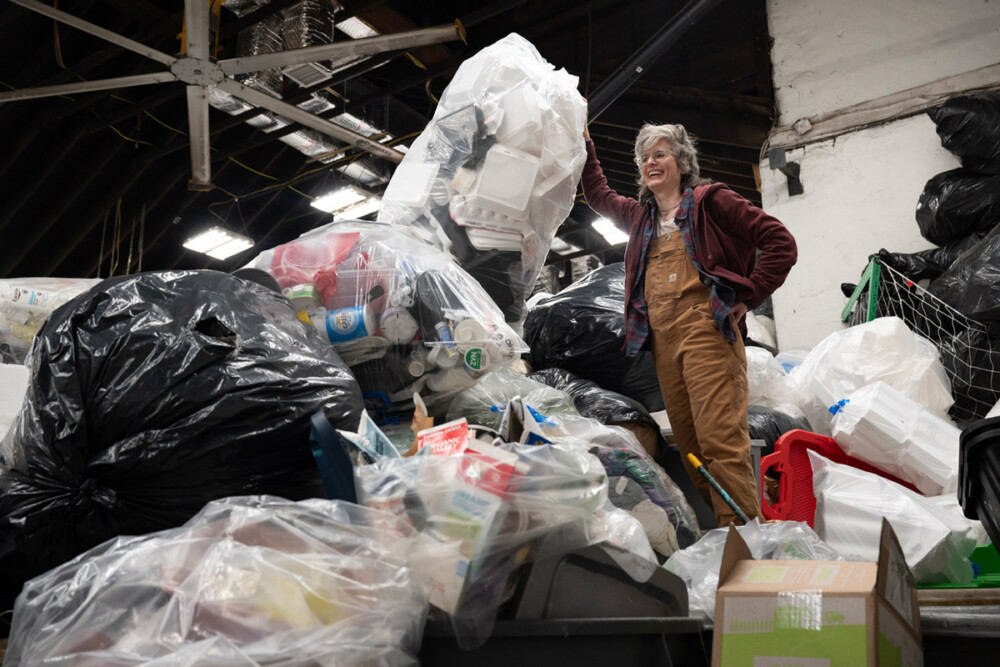
Four Ways to Improve Recycling in Philly
Recycling in Philly is broken. Here’s how Mayor Parker’s administration could fix it.
Recycling in Philly has lost its way. In recent years, between Covid-caused labor shortages and China no longer buying U.S. recyclables, residents lost faith in the system. Recycling rates plummeted. By spring 2022, Philadelphia’s recycling rate was 8 percent. Today, we’re at a not-much-better 13 percent. (For more on why this is, read this piece from The Citizen.)
But there are ways to fix recycling in Philly. Places like San Francisco, CA and Boulder, CO have worked with their contractors to make more materials available for recycling and partnered on educational initiatives, while bans on certain products have helped remove common contaminants from recycling streams.
These tactics are working. San Francisco has the best recycling rate in America. Boulder has raised its landfill diversion rate to above 50 percent, topping the national rate of 32 percent.
The Streets Department did not respond to many of our questions about what they’re planning to do, but with a new mayor — who made cleaning and greening the city a major part of her campaign — and a fresh City Council, Philadelphia has an opportunity to make significant changes to the way it approaches recycling.
Here are four ways the City could improve recycling in Philly — if officials are willing to get a little creative.
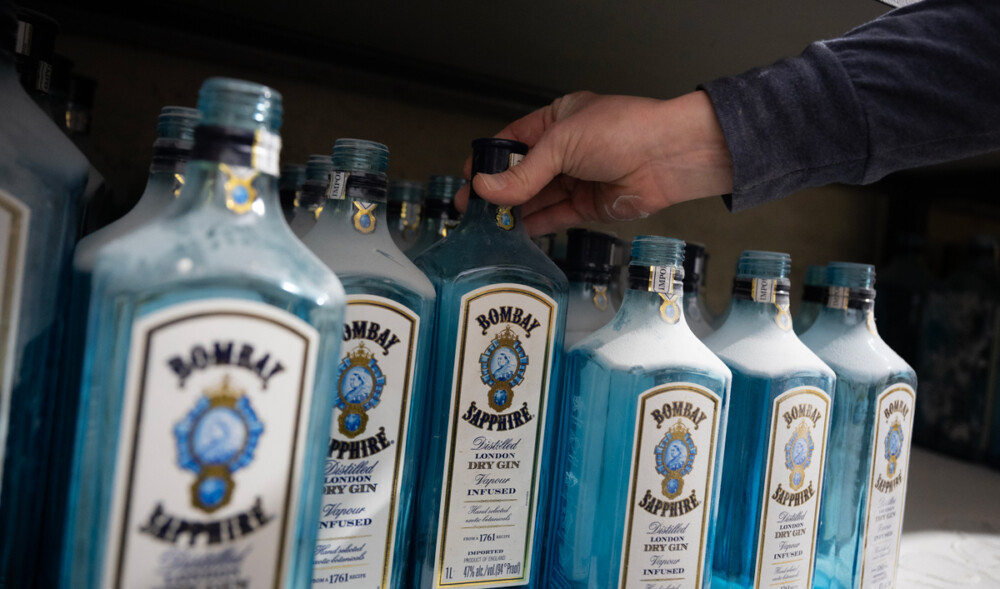
1. Reconsider the city’s recycling partners
Recycling contractors have a huge effect on the system as a whole. They control where materials are sold, determine how much contamination is acceptable and which materials can be recycled. They can also help educate residents about recycling.
To process all of the recyclables collected curbside by city workers, the City contracts with WM, a large, multinational company headquartered in Houston. Philly’s contract with WM ends in 2025, and one path the city could take is choosing a contractor whose business model is all about recycling.
WM owns or operates 263 landfill sites in the U.S. and Canada and about 100 materials recovery facilities (MRFs) that process recyclables so they can be sold to mills that make them into new materials.
John Hambrose, WM’s communications manager for the greater Mid-Atlantic, says that the company is committed to recycling. But activists in Philly and nationally have been critical of companies like WM that process recycling and own landfills.
“Do they really care?” says Nic Esposito, director of policy and engagement for Circular Philadelphia and the city’s former Zero Waste and Litter Cabinet director. “At the end of the day, they’ll make a little bit of money off it [recycling], but if they send it to the landfill it they’re making that money too.”
Recology, San Francisco’s longtime recycling provider, for example, owns landfills. But they also own 10 times as many MRFs. Recology has also helped the city create additional programs, like citywide composting, that divert waste from landfills. They also play a major role in helping San Francisco ensure residents recycle correctly.
“They have their little army of people that are also doing outreach,” says Freddy Coronado-Barraza, residential zero waste specialist for the San Francisco Department of the Environment. “It’s a really big effort that’s proven pretty successful.”
Recology has also worked with the city to make sure contaminated recycling loads still get recycled. Contamination occurs when residents put non-recyclables, like plastic bags and styrofoam containers, into their bins. These materials clog MRFs and lead to a lot of recyclables getting thrown out.
According to a spokesperson from Philadelphia’s Streets Department, the contamination rate in Philly needs to be about 0.5 percent for recycling to be successful. In San Francisco, city officials negotiated with Recology to allow loads with contamination rates between 10 and 15 percent to be recycled.
As a result, San Francisco currently has a recycling rate of a whopping 80 percent — and has kept it there despite losing the Chinese market and the pandemic. (The last time San Francisco had a recycling rate that looked anything like Philly’s was in 1989, when it diverted 10 percent of waste from landfills.)
Right now, Recology works with cities on the West Coast, but they’ve also worked with officials in several other cities — as well as delegations from 135 countries — to teach them how to set up similar programs. If Philly wants to improve its recycling and waste management systems, it’s not a bad place to learn from.
2. Work with multiple vendors
“One of the benefits of working with many partners is we can get services that are specifically tailored to our needs, and it has the added benefit of keeping money in the local economy.“
— J. Cody Lillstrom, Boulder County Resource Conservation Division
Boulder County, Colorado, works with seven different vendors to provide recycling services. It contracts with the nonprofit Eco-Cycle to operate its county-owned MRF. Eco-Cyle also runs the county’s drop-off center for hard-to-recycle materials, which takes everything from electronics to toilets and mattresses. Other vendors take electronics for recycling, while a company called GreenSheen helps recycle paint.
To avoid confusing residents, Boulder uses Eco-Cycle for its single-stream curbside recycling, and its drop-off program for hard-to-recycle materials while also contracting with other vendors for dropoff programs that handle niche items like electronics, tires and other materials. Between recycling and composting, Boulder diverted 53 percent of its waste from landfills in 2020.
“There isn’t a waste management contractor in our area that could meet all of our needs, especially in our drive towards zero waste, because many of the services we offer are fairly niche,” J. Cody Lillstrom, deputy director for the Boulder County Resource Conservation Division, says in an email. “One of the benefits of working with many partners is we can get services that are specifically tailored to our needs, and it has the added benefit of keeping money in the local economy.”
Groups like Esposito’s Circular Philadelphia have advocated for a multi-vendor approach. Multiple contractors, he says, would allow Philly to expand what can be recycled by partnering with companies that have a vested stake in recycling those materials.
Smaller, local companies can also engage more actively with residents and host educational initiatives, which might take some of the burden off of the City.
A number of small operations in Philly already provide these services. The nonprofit Bottle Underground collects glass and recycles it for use through a partner, for-profit ReMark Glass, and sells it to another company that downcycles it into sand for waste-based soils. Last year, Bottle Underground collected more than 300,000 pounds of glass, according to board member Rebecca Davies. Rabbit Recycling is a private curbside service that recycles pretty much everything set out on certain days of the week or month.
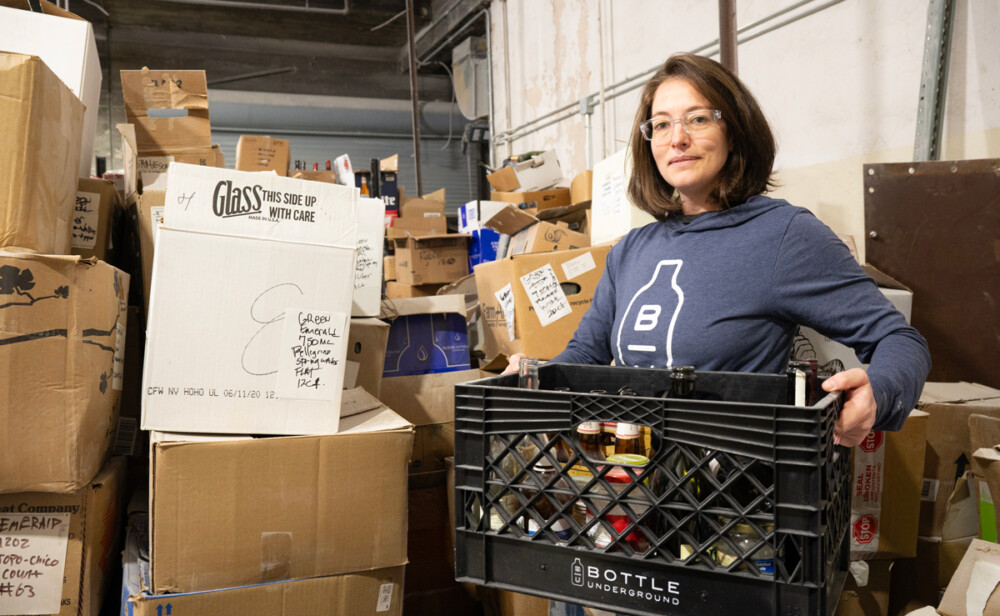
For more complicated materials like construction waste, which often ends up dumped in vacant lots, the City could contract with Richard S. Burns & Co., similar to how Boulder works with its Center for Hard to Recycle Materials. Ryan Fitzpatrick, a business development specialist with Burns, says the company typically processes 800 tons of waste, including styrofoam, drywall and other materials each day.
Many of these small operations would need to scale up to handle the volume that working with the City would entail. “Getting from a small non-profit to operating a materials recovery facility, or even just transferring material — it’s kind of a whole different level of logistics,” Davies says, though he says the company is “definitely interested in those dialogues.”
Matt Siegfried, co-founder and co-owner of Rabbit Recycling, also believes there would be challenges to this approach. Right now, the business operates on a subscription model and relies on subscribers washing the materials before they go into their bins. He estimates that about 90 percent of the material they get is clean enough for them to sell it, a number that would be unlikely to translate if the service went citywide.
“It’s not for everyone,” he says, noting that some of his customers use the service because they’ve grown frustrated with wondering whether the City and WM actually recycle their materials.
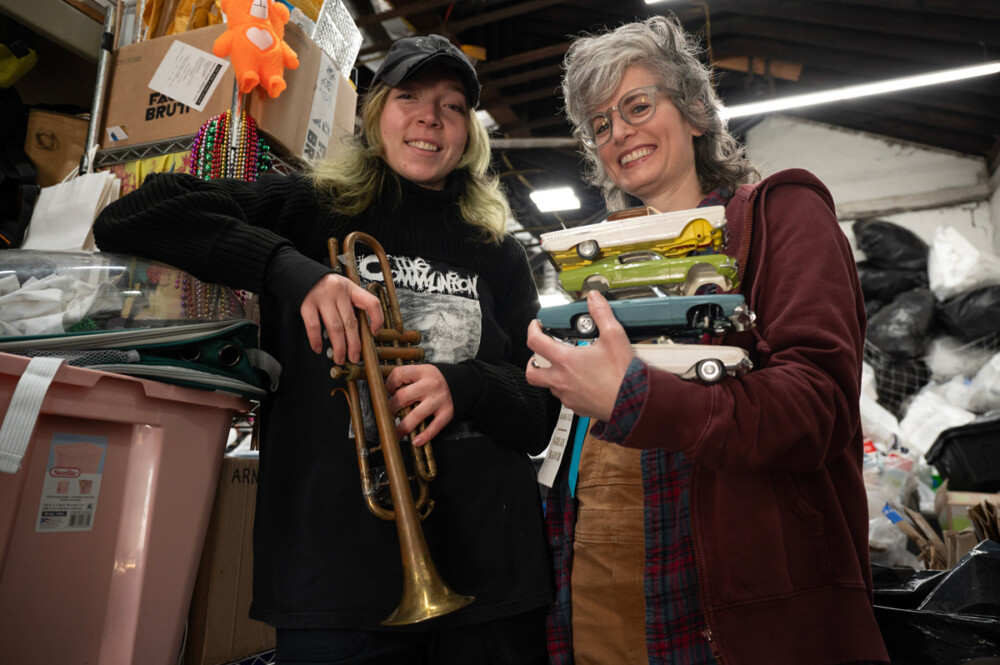
In the absence of the City expanding what can be recycled, some retailers in Philly are teaming with these smaller ventures to increase the number of residents that have access to them. Ray’s Reusables, a Northern Liberties-based business, works with Bottle Underground and Rabbit Recycling to collect contact lenses, rubber bands, chargers and other materials the City doesn’t recycle. Anyone can bring items in during the shop’s monthly collection periods. Patrons donate to cover the cost of recycling through the store. It’s a way to expand services without requiring every city resident to purchase their own, individual subscription to these kinds of services.
“Everything that we offer for recycling in the shop is stuff that you can’t actually put into the curbside bin,” Ray’s Reusables Owner Ray Daly says. “So if not for these specialty recycling services, it would just go straight into landfill.”
3. Really commit to educating residents
Working with the right recycling contractor will only go so far in improving the City’s recycling effort. Whether Philadelphia works with one company or splits the contract into multiple parts, contamination will still be an issue. Mills that buy recycled materials want clean loads. That doesn’t change with who owns the MRF.
Education can help reduce contamination issues, but it can also be labor and resource-intensive.
San Francisco runs an assertive campaign with the department’s grassroots team Environment Now. The city sends mailers out every other year — and goes door-to-door to businesses and residents.
One critical component is reaching residents early. “Our success has been driven by education,” Coronado-Barraza says. Every third-through-fifth grader in the city’s schools travels to see recycling facilities. “All our students in San Francisco are pretty aware of our recycling. That helps, in turn, get their families, their households, to participate.”
Like San Francisco, Denver has implemented a comprehensive educational campaign as part of their Waste No More initiative. The city partners with schools and community organizations, holds presentations for residents and uses social media to provide updates. Denver has also created an app that lets residents search for what materials can and can’t be recycled and provides updates about scheduled pickups.
Notably, Denver also charges residents a monthly fee based on how much trash they throw away, an approach they credit with increasing recycling rates by 13 percent between 2022 and 2023.
Philadelphia’s sanitation division currently attends community events, runs public service campaigns on TV, radio and social media, passes out magnets and distributes flyers to help teach residents what materials can be recycled. The department credits the campaigns with leading to a 4,000-ton increase in the number of recyclables collected in February 2024 compared to the previous year.
The Streets Department did not respond to questions about how many educational events they ran in 2023 or how many they plan to hold in 2024, so it is difficult to gauge how Philadelphia’s efforts compare to those in other cities. Yet activists say they’d like to see the City doing more. “We don’t have good education on what to recycle in Philadelphia,” says Logan Welde, a senior staff attorney and director of legislative affairs for the Clean Air Council, Philly’s oldest environmental nonprofit.
Mayor Cherelle Parker’s five-year strategic plan calls for neighborhood-based education campaigns to reduce contamination and boost recycling rates, with the goal of reaching 40,000 monthly impressions, a metric that determines how many people engage with the initiatives and content. The plan also calls for increasing educational initiatives in partnership with the Philadelphia Housing Authority and schools.
Parker has spent $360,120 on an anti-littering ad campaign, the Philadelphia Inquirer reported earlier this month, much of which came from a state grant. Activists and the Inquirer questioned how much the ads, which run on SEPTA, cable TV, print and online, looked like political marketing for Parker rather than waste reduction education. Last year, the City spent $190,000 on anti-littering ad campaigns. [1]
4. Ban common contaminants at the root of the problem
“There are certain things that just shouldn’t be coming into the city, like styrofoam,” Welde says. “People have this illusion that those things are free, and that those things don’t cost our society.”
In San Francisco, the elimination of common contaminants was another factor in helping recycling efforts. Styrofoam food packaging has been banned since 2007, a prohibition expanded in 2016 to include almost all styrofoam products. Plastic bags, too, have been banned since 2007, though there are exemptions for bags made of thicker plastic that could be considered reusable due to state policy. Now, when Recology collects their waste, they can worry less about these items clogging up MRFs and causing entire loads to be junked.
Philly’s plastic bag ban is already helping do this. Many activists agree that plastic bags, which knot up MRFs and are notoriously difficult to recycle, shouldn’t be in the waste system at all. Researchers estimate that Philly’s ban led to the elimination of over 200 million plastic bags from the City and its waste stream.
Limiting the availability of plastic bags means residents are less likely to toss them in their blue bins, which in turn means they’re less likely to get tangled up in an MRF. By reducing such contamination, the ban has allowed officials to negotiate for lower recycling processing fees, which saved the city over $1.5 million, per Parker’s strategic plan.
“We calculated that the plastic bags cost Philadelphia about $12 million or so in dealing with that as an issue,” Welde says. “We had billions of plastic bags coming into the city. And that’s really been slowed down a lot by the legislation.”
Philly could take that a step further. Circular Philadelphia has policy recommendations like banning or adding a fee to single-use plastics containers for takeout food. Or, the City could implement programs to encourage restaurants to switch to reusable takeout containers like Tiffin’s Tiffin2Go program.
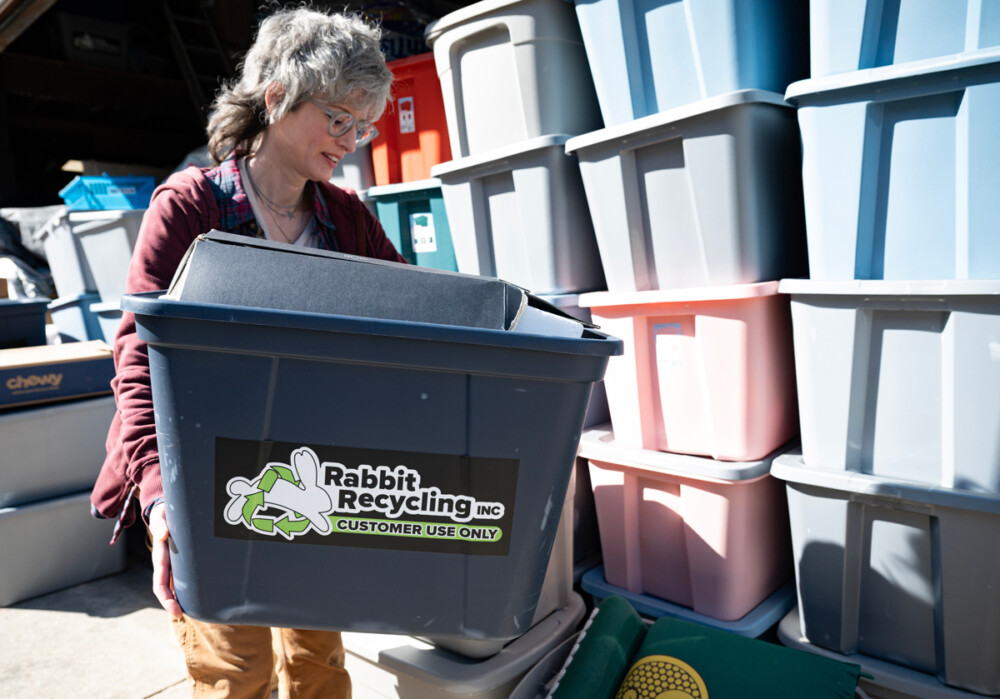
Can Philly achieve this?
“I don’t expect Carlton Williams — or anyone that’s been in this program for as long as him — is going to be creative and come up with any of these different tactics.”
— Logan Welde, Clean Air Council
Mayor Cherelle Parker has been clear that cleaning up Philly — ending illegal dumping, improving recycling, retiring that tired nickname Filthadelphia — is a priority. Her five-year financial and strategic plan includes implementing twice-weekly trash collection, expanding street sweeping and adding more trash and recycling bins around the city. The plan also has a goal of reaching a 15 percent recycling rate by fiscal year 2025.
“I’m hopeful with Cherelle Parker,” says Maurice Sampson, Eastern Pennsylvania director of Clean Water Action. He was also the City’s first Recycling Program Administrator. “She is deadly serious about cleaning up.”
But many remain skeptical that Philly will be able to boost its recycling rates. For one, it’s not clear what some of Parker’s planned initiatives will actually do. Take the Office of Clean and Green for instance: A Streets Department spokesperson did not respond to how specifically the cabinet will do that — or if they had set any specific goals. The City also did not respond to questions about how the split between Streets and Sanitation will affect recycling, other than to say that recycling will remain housed under the Sanitation Department. It also wouldn’t answer questions about whether the City would consider a recycling contract with a company focused on recycling or whether the City has plans to support smaller recycling ventures in the city. (The new confusing website also seems to link to existing City resources.)
Another reason for the skepticism: lack of new thinking about the issue among city leadership. In December, Parker announced that a familiar face would be heading up her Clean and Green Initiatives: former Streets Commissioner Carlton Williams, who had served in that role since 2017. (You might remember him as the guy in charge of the Department of Licenses and Inspections when a building undergoing demolition collapsed on Market Street in 2013, killing six people and injuring 14.)
Williams brings a wealth of experience, but some activists also see him as a symbol of everything that has been broken with the city’s waste management systems. “I don’t expect Carlton Williams — or anyone that’s been in this program for as long as him — is going to be creative and come up with any of these different tactics,” Welde says. “People who have been in the department … really just have a very myopic view of how to deal with waste issues.”

Photos by Sabina Pierce









